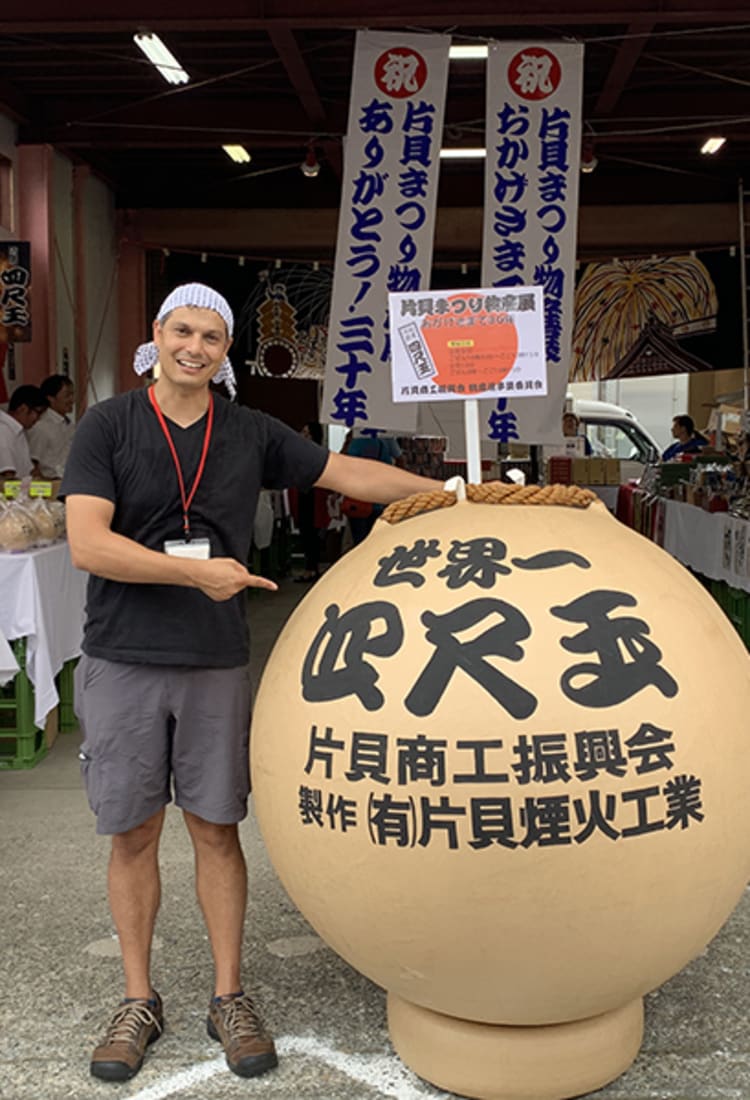
2020.08 A YouTube Star on the Joys of Japanese Fireworks Festivals
”Japanese fireworks displays are an amazing art form!”
Fireworks festivals have been a part of traditional Japanese culture for nearly three hundred years. They are held throughout the country during the summer months and draw huge crowds. Some of the most spectacular shows attract people in their hundreds of thousands or even millions.
This year, the COVID-19 pandemic has caused the cancellation of fireworks shows nationwide; however, one American YouTuber has thrown himself into the task of crafting original fireworks and broadcasting them live to the world from Japan. His name is John Daub. He's become widely known as the ONLY in JAPAN series producer on YouTube and the mobile live streaming channel ONLY in JAPAN * GO highlighting Japan's history, culture, food, technology, and other aspects of life in Japan from his individual perspective. In June, he leveraged the popularity of his channel to launch a new one called John Daub * ONLY in JAPAN.
John has hitchhiked through all 47 prefectures of Japan, making him knowledgeable on many aspects of Japanese culture, and he also works as a global reporter for national broadcaster NHK. Last year, his video covering the fireworks artisans and fireworks festival in Niigata Prefecture earned a record-breaking six million views. We asked John to tell us why he's so enamored with Japanese fireworks and how best to enjoy them.
Amazingly huge, with gorgeous colors and presentation… this is entertainment like you’ve never experienced before
"The first summer I spent in Japan after moving here in 1998, I went to my first fireworks festival—the Okazaki Castle Hero Ieyasu Summer Festival & Fireworks in Aichi Prefecture—and was shocked. American fireworks shows tend to have only a few hundred fireworks, and displays only really happen on Independence Day or at baseball games or theme parks. But at this show, they set off 20,000 fireworks over the course of two hours!"
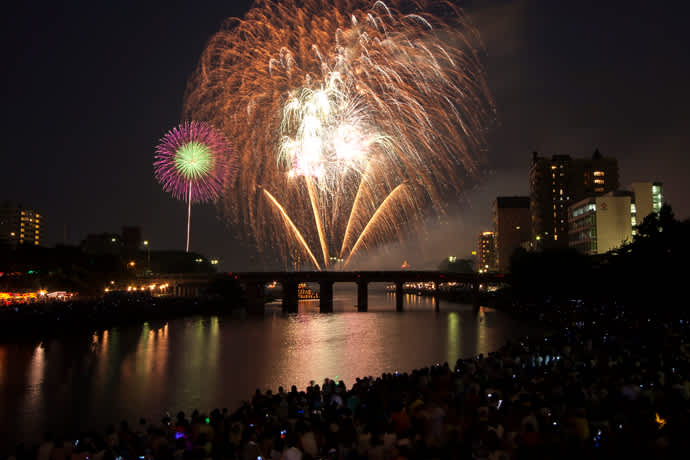
Traditional Japanese fireworks, known as warimono
"I was amazed at the size, the diversity, the beautiful colors, and how they were set to music. I was blown away by this crazy spectacle; it was something I’d never experienced before. Japanese fireworks, I thought, are truly an art form."
A deeper experience of traditional Japanese culture
"Fireworks festivals are special occasions; they offer opportunities to experience authentic Japanese culture. To start, people dress in summer kimono, or yukata. Modern Japanese people don’t normally wear them, but everyone puts them on for a fireworks festival. Japanese people also tend to be more friendly and outgoing on festival days, calling out with a smile to non-Japanese people wearing yukata. It’s a quick way to make friends!"
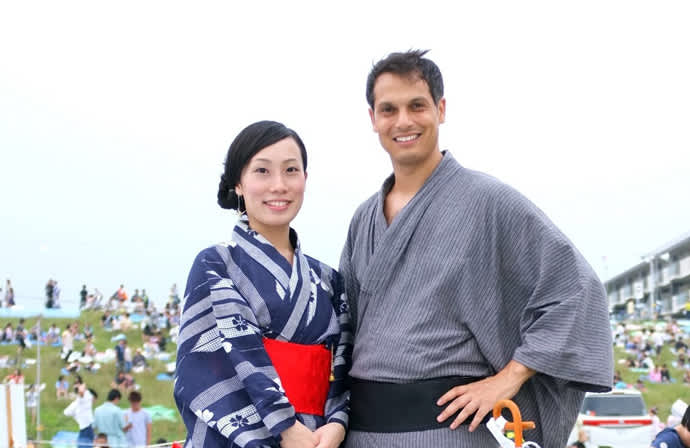
John Daub (right) and his wife, Kanae (left), in the John Daub* ONLY in JAPAN series
"The fireworks show usually starts around 7 PM, but the festival is an all-day event. Traditional music fills the air and there are many different food stalls that start up around midday. Just hanging around amidst the delicious smells of takoyaki, okonomiyaki, yakisoba, and other classic festival foods is a thrill."
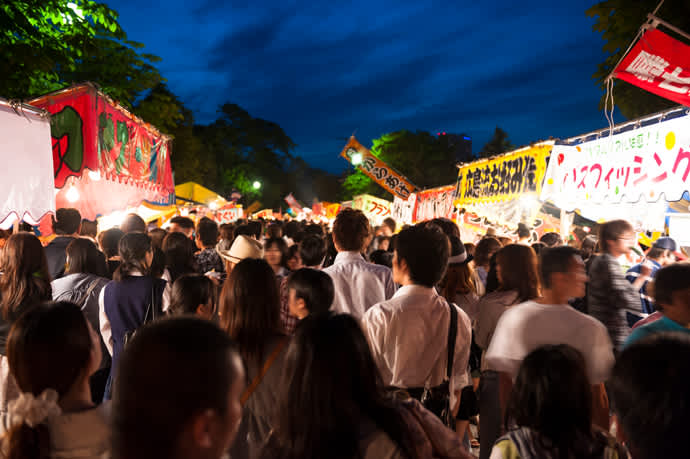
"The festival stalls get jam-packed as evening falls. Most of them only take cash, so you can’t use credit cards or other cashless payments."
"If you go, you’ve definitely got to try the osakayaki, which is only sold at street stalls. They’re like small pancakes topped or filled with okonomiyaki ingredients—delicious and easy to eat with one hand. Beer is the go-to beverage during summer, but don’t pass up the sake if you visit a region that specializes in brewing it, like Nagano Prefecture."
"The typical way to enjoy a fireworks show in Japan is to buy a bunch of food and drinks at the street stalls and then spread out a tarp and enjoy them with family and friends. If you want to find the perfect spot, you can’t just walk up when it’s time for the show to start—you’ve got to stake it out one or two days in advance. Once, ten years ago, I went to a spot I’d staked out every day for a month to make sure it was still there!"

Osakayaki (left) and people sitting on a tarp enjoying fireworks while snacking on food they got at street stalls or a supermarket (right)
John Daub’s most memorable fireworks festivals
Some of the world’s largest fireworks, crafted by “firework artists”
"This fireworks festival features the yonshaku-dama, one of the largest fireworks in the world. The shell measures 120 centimeters (3.9 feet) and weighs 420 kilograms (925 pounds). When the firework explodes, it opens out across 800 meters (more than 2,600 feet) ! It’s unbelievably huge. I talked to Masanori Honda, the craftsman who made the firework, and he told me that it takes months to create the yonshaku-dama (which draws a crowd of some 200,000 people) every year. I realized this man was a true firework artist."
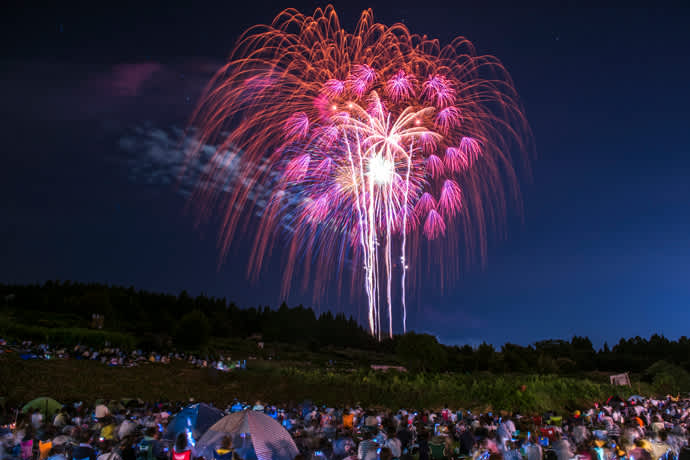
The Katakai Fireworks Festival features many individually-sponsored fireworks. When one is set off, a message from the sponsor gets read out.
Katakai Fireworks Festival
The Katakai Fireworks Festival is held annually, typically on September 9, at Asahara Shrine. Nearly 200,000 spectators attend each year to see some 15,000 fireworks launched over the course of two day
Feel the blasts reverberate as fireworks explode over a gorgeous lake
"Lake Suwa is a popular sightseeing destination because of its beautiful scenery. It’s the perfect setting for a fireworks festival because you get great views no matter where you sit along the shore. The are also mountains all around, which adds to the experience. When fireworks explode, the sound reverberates off the mountains in booms. The display comes to a climax with a star mine launched from the surface of the lake and the Niyagara Falls firework which explodes across a distance of two kilometers (1.2 miles)."
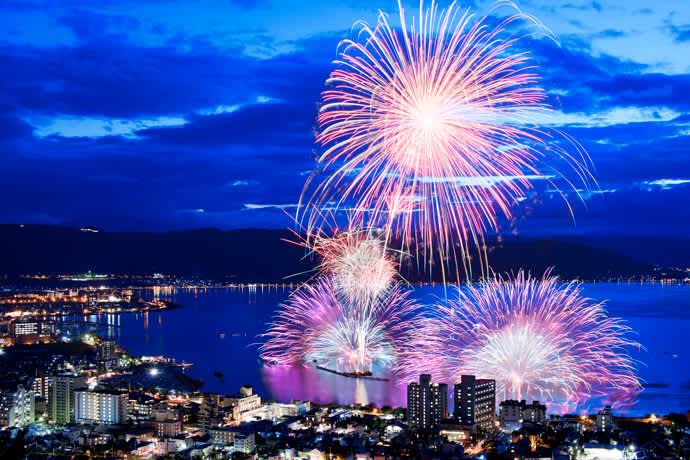
The Lake Suwa Fireworks Festival is one of Japan’s largest, and the display is divided into two parts. The first is a competition of pyrotechnic skill, while the second is a display of particularly large fireworks set off in quick succession.
This is arguably one of the best shows in Japan. The festival is typically held on August 15 at Lake Suwa, and the display includes some 40,000 fireworks.
A magical fireworks display against the backdrop of Itsukushima Shrine's great torii gate
"Miyajima is the tranquil island that’s home to Itsukushima Shrine, a renowned World Heritage Site. The area is close enough to Hiroshima for a day-trip visit, but many people stay overnight for the fireworks festival. I chose to lodge at a shrine nearby. The sight of the great torii gate rising out of the ocean is magical, and provides an amazing stage for the evening’s light show. It’s a scene that pulses with the old traditions of Japan, and a sight I’ll never forget."
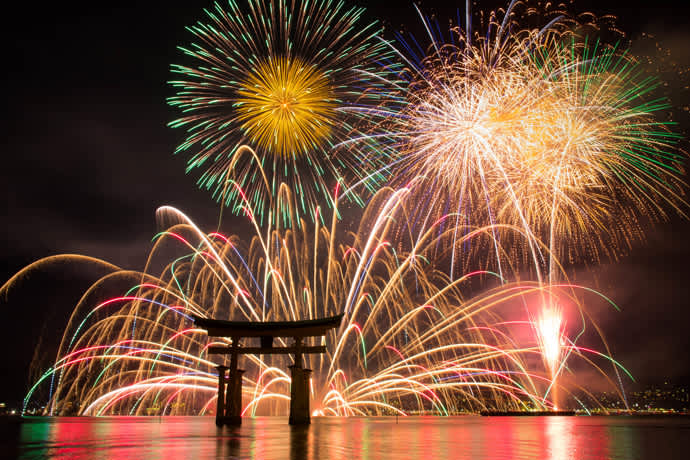
The Miyajima Water Fireworks Festival is counted among the hundred best fireworks displays in Japan
Miyajima Water Fireworks Festival
The festival is typically held in August, and the display boasts some five thousand fireworks. It has been held since the Edo period (1603-1867).
“I want to help create a fireworks event that will bring hope to the world”
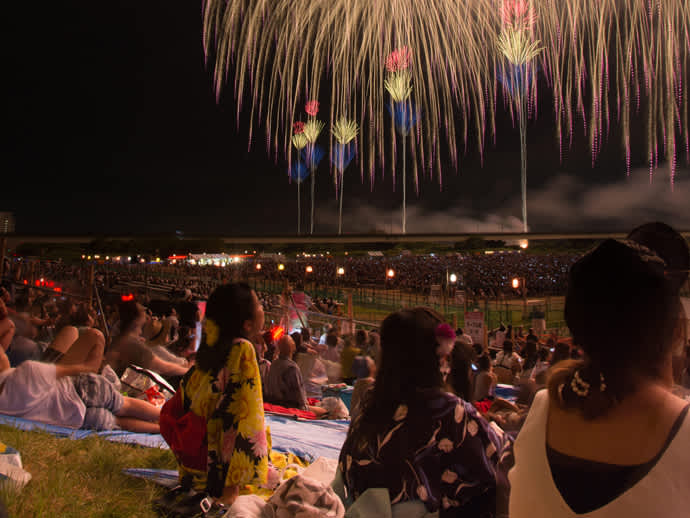
"Fireworks festivals across Japan have been postponed or canceled this year due to the COVID-19 pandemic. I adore these festivals, and the whole situation is so sad and unfortunate. However, it’s given me the impetus to bring them back."
"I am planning an event with the help of countless supporters from the Japan Hanabi Association and the rest of the fireworks industry. The artisans have agreed to craft original fireworks to launch this fall and broadcast free of charge—creating an amazing opportunity for people to see them. That said, doing something like this is incredibly expensive, so we’ve launched a Kickstarter fund to help bear the costs."
"Japan hosted its first fireworks festival in the year 1733. Cholera had devastated the population the year before, taking the lives of 900,000 people through sickness and starvation. The fireworks shooting skyward were an expression of hope, and people believed they might soothe the souls of the departed as well as drive away the terrible sickness."
"With so many people dying of the coronavirus all over the world, the situation today is not much different. My wish is to join with the fireworks community of Japan in bringing the light of hope to the global community once more as we mourn the loss of so many lives."
"At the same time, the event is a chance for people around the world to experience the beautiful traditions of Japan, which will hopefully inspire them to visit and enjoy this amazing country in person someday."
Note: All of the fireworks festivals mentioned in this article have been canceled this year due to the COVID-19 pandemic.




























































